|
1926
|
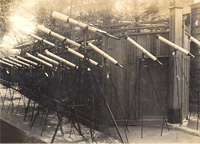 Seizo Goto established GOTO OPTICAL MFG. Co. as a private company in his house in Sangenjaya, Setagaya-ku, Tokyo. GOTO started manufacturing a single lens refractor telescope with effective aperture of 25mm and focal length of 80mm. Due to its unprecedented low price, orders from amateur astronomers rushed in.
Seizo Goto established GOTO OPTICAL MFG. Co. as a private company in his house in Sangenjaya, Setagaya-ku, Tokyo. GOTO started manufacturing a single lens refractor telescope with effective aperture of 25mm and focal length of 80mm. Due to its unprecedented low price, orders from amateur astronomers rushed in. |
|
1936
|
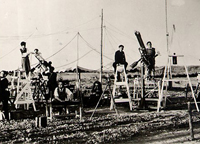 GOTO succeeded in photographing a total solar eclipse and the sun’s flash spectrum in Okoppe, Hokkaido, Japan with the cooperation of the Asahi Shimbun newspaper and was awarded a prize by the Ministry of Education and the Society of Astronomy in Japan. A movie of the eclipse, named “BLACK SUN” was produced.
GOTO succeeded in photographing a total solar eclipse and the sun’s flash spectrum in Okoppe, Hokkaido, Japan with the cooperation of the Asahi Shimbun newspaper and was awarded a prize by the Ministry of Education and the Society of Astronomy in Japan. A movie of the eclipse, named “BLACK SUN” was produced. |
|
1954
|
Enactment of the Science Education Promotion Act went into effect and projects of enhancement of science equipment in elementary, junior high and high schools were conducted. GOTO developed telescopes and astronomical projectors in accordance with the Act and distributed them to schools throughout Japan through science product supply companies. GOTO attained a market share in this business of over 90%. |
|
1959
|
Development of the Model M, a lens type, middle-size, projection planetarium was completed. It was displayed at the Tokyo International Trade Show. The first M-1 was installed in the Asakusa Shin-Sekai(New World) building in Asakusa, Tokyo and the second one was delivered to the Museum of Art, Science and Industry in Bridgeport, Connecticut in USA. GOTO opened up a new market of planetarium projection equipment and services in addition to its previous telescope manufacturing business. |
|
1960
|
GOTO won a contract for a large planetarium for McDonnel Planetarium, in the city of Saint Louis, Missouri, USA after international bidding. The large size planetarium, Model L-1 was installed. (1962) |
|
1963
|
GOTO moved to Fuchu (present location) from Komazawa. The S Model, lens projection type small-size planetarium was developed. Planetarium installations began to be introduced to schools in Japan and an agreement with a USA agent was made to increase international sales. |
|
1967
|
A five-year exclusive sales contract was conducted with Viewlex, USA. In the next year, GOTO received an ordered by Viewlex for 10 Eros (E-5) and 100 Apollos (a GOTO OEM product following Eros) and many GOTO products were installed in to USA. |
|
1969
|
Although the specification was very demanding, GOTO got an order for the customs model L-1 for Vanderbilt Planetarium in New York State, USA. The line-up of GOTO planetariums was completed for exportation. They were named: Eros, Apollo, Mercury – Pin-hole type, and the opto-mechanical (lensed) types Venus(S-3), Mars(M-1), Jupiter(M-2), Saturn(L-1). |
|
1970
|
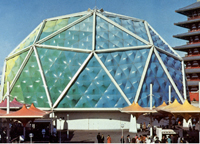 Astrorama (consisting of 5 projectors for 70mm 5 perf. film), the world’s first pano-hemispheric motion picture system, was delivered to the Midori Pavilion of EXPO’70. It was recognized as a pioneering facility exhibiting dome motion pictures for expos. After that, GOTO produced films with its own equipment and participated and planned projects for films at domestic and overseas events.
Astrorama (consisting of 5 projectors for 70mm 5 perf. film), the world’s first pano-hemispheric motion picture system, was delivered to the Midori Pavilion of EXPO’70. It was recognized as a pioneering facility exhibiting dome motion pictures for expos. After that, GOTO produced films with its own equipment and participated and planned projects for films at domestic and overseas events. |
|
1971
|
The development of Planetarium G series was started, and quickly caused a planetarium boom. The Saturn (L-1 custom made) large-size planetarium for Vanderbilt was installed. |
|
1972
|
The GM-15-AT , Japan’s first fully automatic planetarium, is completed and delivered to the Kanagawa Prefectural Youth Center, it revolutionizes planetarium shows and eventually leads to today’s boom in fully automatic planetarium. |
|
1975
|
Solar telescope delivered to the Korean National Observatory as gratuitous Japanese governmental assistance. |
|
1976
|
The Marx-X type astronomical telescope and mount was completed. Orders for the telescope rushed in immediately after being released. It had a great impact on amateur astronomers. Also, it had an accelerating effect on development of the apochromatic and short focus lens of many current telescopes. |
|
1977
|
60cm Cassegrain reflector, GOTO ‘s first large telescope is developed. And the telescope was delivered to Korean University. |
|
1978
|
40cm Cassegrain reflectors were delivered to 2 Korean Universities and one to the Astronomy & Space Research Center of Iraq.
The GM-15-T planetarium was delivered to the Taipei Observatory, Taiwan.
|
|
1979
|
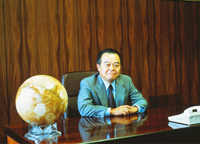 Ryuichiro Goto, grandson of founder Seizo Goto, was appointed President of GOTO.
Ryuichiro Goto, grandson of founder Seizo Goto, was appointed President of GOTO. |
|
1981
|
A Planetarium Software Development Section was established in GOTO for planetarium show production. Planetarium programming changed from simple stellar space to a more multi-image representation space. Goto has created a huge number of various images and shows for planetariums since then. |
|
1984
|
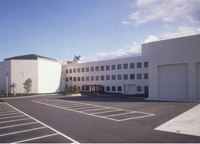 The new Fuchu factory (current building) was completed. GSS, the world’s first “space planetarium” allowing views of the solar system from other planets was developed. The first unit was delivered to the Yokohama Science Center, where a tilted space theater was born.
The new Fuchu factory (current building) was completed. GSS, the world’s first “space planetarium” allowing views of the solar system from other planets was developed. The first unit was delivered to the Yokohama Science Center, where a tilted space theater was born. |
|
1985
|
As the first Planetarium to India, the best selling model of the G series, Model GX, was delivered to the Hyderabad Planetarium. This installation became the first step into the growing Indian market. Bird’s Eye Vision using an Astrovision 70 pano-hemispheric motion picture system was delivered to the Heartpia Pavilion at Tsukuba Science Expo. |
|
1988
|
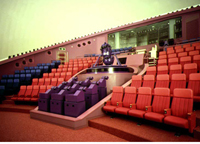 The GSSII for 18-23m domes, the next generation of GOTO Space System planetariums, was announced along with ASTROVISION 70, a pano-hemispheric motion picture. Both technologies supported a great variety of presentations in planetarium domes. GOTO won the bid for the first GSSII and Astrovision 70 system to the overseas market.
The GSSII for 18-23m domes, the next generation of GOTO Space System planetariums, was announced along with ASTROVISION 70, a pano-hemispheric motion picture. Both technologies supported a great variety of presentations in planetarium domes. GOTO won the bid for the first GSSII and Astrovision 70 system to the overseas market. |
|
1989
|
GOTO produced the original film “Mt. Fuji” of a famous image poem, in which Mt. Fuji was shot dynamically using the GOTO Astrovision camera in each of the four seasons. |
|
1990
|
Astrovision was delivered to the Flora Dome at the Flower and Greenery Expo in Osaka. The first camera images combined with computer graphics in large films was shown on the dome screen. |
|
1991
|
Large format movies with the largest film size 15/70 was expanded to the image field in Japan, Korea and Taiwan. Teams were sent to Hawaii and Mexico to film total solar eclipses and succeeded in filming the entire process. The film was later released with the name “BLACK SUN” and shown at many large format film theaters. The film became the world’s first large format film documentary on total solar eclipses. |
|
1992
|
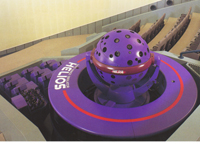 GSS-HELIOS, the world’s first ball-shaped planetarium with 4-axis control space simulation was completed. This design then became the mainstream design in large planetariums.
GSS-HELIOS, the world’s first ball-shaped planetarium with 4-axis control space simulation was completed. This design then became the mainstream design in large planetariums. |
|
1993
|
A temporary Astrovision 70 exhibit was held at the China Science and Technology Museum. The system was then purchased by the Museum and installed on a permanent basis. |
|
1995
|
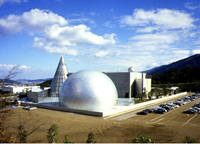 GSS-HELIOS was delivered to the Ehime Prefectural Science Museum (30m diameter dome). It made the Guinness Book of World Records for its world’s largest size.
The contract for the first tilted installation of the Model GSS-HELIOS/ASTROVISION 70 was agreed and it was delivered with an original show next year.
GSS-HELIOS was delivered to the Ehime Prefectural Science Museum (30m diameter dome). It made the Guinness Book of World Records for its world’s largest size.
The contract for the first tilted installation of the Model GSS-HELIOS/ASTROVISION 70 was agreed and it was delivered with an original show next year. |
|
1996
|
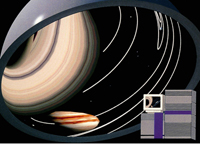 Virtuarium, the world’s first full-color, full-dome, three-dimensional computer graphic dome projection system rendered in real time was developed. It was announced to the world at the International Planetarium Society conference, which was held at Osaka, and shown to a post-conference group in Fuchu.
Virtuarium, the world’s first full-color, full-dome, three-dimensional computer graphic dome projection system rendered in real time was developed. It was announced to the world at the International Planetarium Society conference, which was held at Osaka, and shown to a post-conference group in Fuchu. |
|
1998
|
GOTO joined Honolulu’s Bishop Museum in “The Explorers project ” which was started under a grant from NASA. GOTO cooperated with the museum for contents production for 5 years. The project was delivered to planetarium theaters throughout the USA as a trilogy of shows, and was also distributed internationally. |
|
1999
|
GOTO delivered a large format flat screen system to the Kangwon-do Pavilion for the “INTERNATIONAL TRAVEL EXPO’ 99 KANGWON-DO” and produced an original show for the theater in which various local tourist spots seen during the four season were introduced.
GOTO contracted for a GSS-HELIOS and Astrovision 70 system with Bangabandhu Sheikh Mujibur Rahman Novotheatre in Bangladesh.
|
|
2000
|
GOTO added Mr. Ken Miller to the GOTO sales team to bring Western planetarium concepts to GOTO, and to strengthen planetarium sales in the USA and English speaking countries. |
|
2001
|
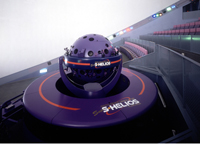 The ultra-high-intensity space planetarium, SUPER-HELIOS was announced.
The ultra-high-intensity space planetarium, SUPER-HELIOS was announced. |
|
2002
|
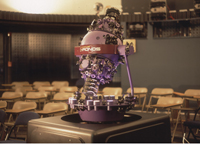 GSS-CHRONOS was developed following extensive user input. It was introduced at the International Planetarium Society’s 2002 conference and gained a strong reputation for incorporating a wide range of helpful opinions from teachers and schools, including digitally controlled planet mechanisms for the first time in medium and small-sized domes. It has since been delivered to many educational facilities in the USA and Japan.
GSS-CHRONOS was developed following extensive user input. It was introduced at the International Planetarium Society’s 2002 conference and gained a strong reputation for incorporating a wide range of helpful opinions from teachers and schools, including digitally controlled planet mechanisms for the first time in medium and small-sized domes. It has since been delivered to many educational facilities in the USA and Japan. |
|
2003
|
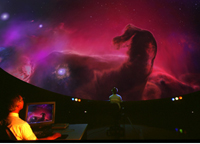 Nobutaka Goto, great-grandson of founder Seizo Goto, was appointed president of GOTO.
Virtuarium II, a second-generation fulldome digital projection system was announced. NEX, portable star ball projection system with which children can easily enjoy stars was released along with Hoshi-Tamago (Star Egg), a special inflatable dome for NEX.
The model GSS-URANUS and ASTROVISION 70LL system was delivered to the Egyptian Military Academy, making it the first ball-shaped planetarium in Egypt.
GOTO delivered a Model GS in the G series to ”El Pequeno Sula, Museo para la Infacia” of the City Hall of San Pedoro Sula, the Republic of Honduras under a Cultural Grant Aid of the Japanese Government. It was the first planetarium theater in Honduras.
Nobutaka Goto, great-grandson of founder Seizo Goto, was appointed president of GOTO.
Virtuarium II, a second-generation fulldome digital projection system was announced. NEX, portable star ball projection system with which children can easily enjoy stars was released along with Hoshi-Tamago (Star Egg), a special inflatable dome for NEX.
The model GSS-URANUS and ASTROVISION 70LL system was delivered to the Egyptian Military Academy, making it the first ball-shaped planetarium in Egypt.
GOTO delivered a Model GS in the G series to ”El Pequeno Sula, Museo para la Infacia” of the City Hall of San Pedoro Sula, the Republic of Honduras under a Cultural Grant Aid of the Japanese Government. It was the first planetarium theater in Honduras.
|
|
2004
|
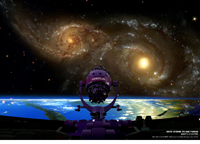 The world’s first HYBRID planetarium, synchronizing a GOTO SUPER URANUS opto-mechanical planetarium and a fulldome digital projection system was delivered to the Morioka Children’s Museum of Science in northern Japan.
The world’s first HYBRID planetarium, synchronizing a GOTO SUPER URANUS opto-mechanical planetarium and a fulldome digital projection system was delivered to the Morioka Children’s Museum of Science in northern Japan. |
|
2005
|
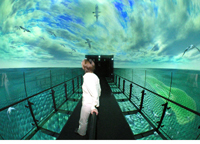 For the 2005 World Exposition, Aichi, Japan, GOTO delivered 4 unique projection systems. The world’s first 360 degree, spherical projection system was installed at the Japanese Government Pavilion and 3 other projection systems were installed at the Global Village, Mitsubishi Future Pavilion and Ireland Pavilion.
GOTO built friendly relations with the American Museum of Natural History in New York City after cooperation for production of “Cosmic Collisions” and cooperated in the production of “Journey to the Stars” (2008) and “Dark Universe” (2013).
For the 2005 World Exposition, Aichi, Japan, GOTO delivered 4 unique projection systems. The world’s first 360 degree, spherical projection system was installed at the Japanese Government Pavilion and 3 other projection systems were installed at the Global Village, Mitsubishi Future Pavilion and Ireland Pavilion.
GOTO built friendly relations with the American Museum of Natural History in New York City after cooperation for production of “Cosmic Collisions” and cooperated in the production of “Journey to the Stars” (2008) and “Dark Universe” (2013).
|
|
2006
|
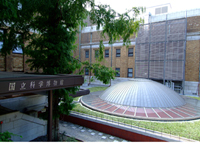 The highly publicized total sphere projection system at the Aichi Expo was transferred to the National Science Museum in Ueno, Tokyo.
The highly publicized total sphere projection system at the Aichi Expo was transferred to the National Science Museum in Ueno, Tokyo. |
|
2007
|
 GOTO installed the state of art, HYBRID planetarium, “CHIRON HYBRID” into the Sudekum Planetarium, Adventure Science Center, Nashville, USA and in large planetarium theaters in JAPAN.
GOTO joined the four-dimensional digital universe project (4D2U) in Japan’s National Observatory and developed a 3D image show for this data visualization theater.
GOTO installed the state of art, HYBRID planetarium, “CHIRON HYBRID” into the Sudekum Planetarium, Adventure Science Center, Nashville, USA and in large planetarium theaters in JAPAN.
GOTO joined the four-dimensional digital universe project (4D2U) in Japan’s National Observatory and developed a 3D image show for this data visualization theater.
|
|
2008
|
 The new Sendai Astronomical Observatory opened. GOTO operates and manages the observatory on behalf of the Sendai Astronomy Service Corporation.
GOTO installed the full dome image system VIRTARIUM II into the National Science Museum, Korea and increased popularity of the planetarium.
The new Sendai Astronomical Observatory opened. GOTO operates and manages the observatory on behalf of the Sendai Astronomy Service Corporation.
GOTO installed the full dome image system VIRTARIUM II into the National Science Museum, Korea and increased popularity of the planetarium.
|
|
2009
|
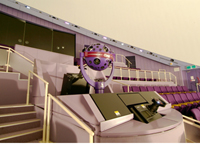 SUPER-HELIOS HYBRID was delivered to China Science & Technology Museum, China and CHIRON HYBRID was delivered to Planetarium (Nay Pyi Taw) Myanmar.
A planetarium system installed by other maker was updated WITH HYBRID technology by GOTO and installed “VIRTUARIUM II”.
It became possible to integrally control other maker’s optical planetarium with our full dome digital projection system. The HYBRID SYSTEM facilities are increasing at home and overseas.
SUPER-HELIOS HYBRID was delivered to China Science & Technology Museum, China and CHIRON HYBRID was delivered to Planetarium (Nay Pyi Taw) Myanmar.
A planetarium system installed by other maker was updated WITH HYBRID technology by GOTO and installed “VIRTUARIUM II”.
It became possible to integrally control other maker’s optical planetarium with our full dome digital projection system. The HYBRID SYSTEM facilities are increasing at home and overseas.
|
|
2010
|
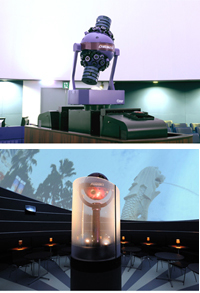 The super luminosity, LED-equipped CHRONOS II and PANDIA were released. The first CHRONOS II was delivered to Shinagawa City Gotanda Culture Center and the first PANDIA was installed at the renovated international terminal of Tokyo (Haneda) International Airport.
The super luminosity, LED-equipped CHRONOS II and PANDIA were released. The first CHRONOS II was delivered to Shinagawa City Gotanda Culture Center and the first PANDIA was installed at the renovated international terminal of Tokyo (Haneda) International Airport. |
|
2011
|
GOTO joined the production of “Dinosaurs at Dusk” by Mirage 3D. It built the friendly relationship with Mirage 3D. |
|
2012
|
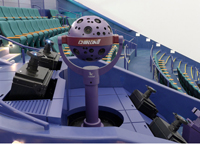 An LED-equipped CHIRON was introduced as CHIRON II and installed in Tama Rokuto Science Center in 2012. This has been recognized as the “Most advanced planetarium” in the world.
GOTO installed a “CHRONOS II HYBRID” into the Raumflugplanetarium Juri Gararin in Cottbus, Germany, the country where the planetarium was born. It expanded the sales to Europe.
The first full dome digital show program “A PLANET FOR GOLDILOCKS” intended for overseas distribution was announced at the IPS conference held at Baton Rouge, USA. This show won the Best Audio Track award at the IMILOA FULLDOME FILM FESTIVAL, Hawaii, USA.
An LED-equipped CHIRON was introduced as CHIRON II and installed in Tama Rokuto Science Center in 2012. This has been recognized as the “Most advanced planetarium” in the world.
GOTO installed a “CHRONOS II HYBRID” into the Raumflugplanetarium Juri Gararin in Cottbus, Germany, the country where the planetarium was born. It expanded the sales to Europe.
The first full dome digital show program “A PLANET FOR GOLDILOCKS” intended for overseas distribution was announced at the IPS conference held at Baton Rouge, USA. This show won the Best Audio Track award at the IMILOA FULLDOME FILM FESTIVAL, Hawaii, USA. |
|
2013
|
GOTO installed the “CHRONOS II HYBRID” into Brno Observatory and Planetarium, Czech Republic. |
|
2014
|
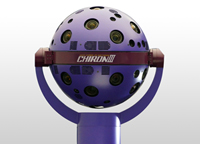 GOTO developed “CHIRON III” which has all stars showing their intrinsic color temperature.
The first PANDIA HYBRID to overseas market was installed into HwaCheon ChouKyongChol Observatory, Korea and secondly into the Planetarium Ostrava, Czech Republic.
GOTO developed “CHIRON III” which has all stars showing their intrinsic color temperature.
The first PANDIA HYBRID to overseas market was installed into HwaCheon ChouKyongChol Observatory, Korea and secondly into the Planetarium Ostrava, Czech Republic.
|
|
2015
|
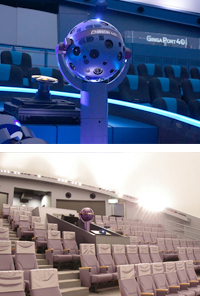 Based on the GOTO Model CHIRON III, a special “CHIRON 4○1” was created and installed at Yokkaichi Municipal Museum, Japan. The successor to PANDIA, the Model PANDIA II was developed with digital shutters built into the starball, allowing use in tilted domes. (Note: PANDIA projectors are named PANDORA in Japan)
Based on the GOTO Model CHIRON III, a special “CHIRON 4○1” was created and installed at Yokkaichi Municipal Museum, Japan. The successor to PANDIA, the Model PANDIA II was developed with digital shutters built into the starball, allowing use in tilted domes. (Note: PANDIA projectors are named PANDORA in Japan) |
|
2016
|
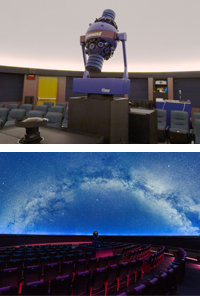 2016 marked a unique, third installation of a GOTO projector in a single American planetarium. The College of San Mateo (California) completed its upgrade from a CHRONOS HYBRID with 2K fulldome video to a new CHRONOS II HYBRID with 4K fulldome video in January. This upgrade followed an earlier replacement of their original CHRONOS projector after it was destroyed in flooding. GOTO INC is very proud to receive such customer loyalty and confirmation of the HYBRID concept by our users.
For the first time in 14 years, GOTO INC made an international premiere of one of its opto-mechanical projectors at the International Planetarium Society’s 2016 conference in Warsaw, Poland. A 16m air dome was temporary home to a CHIRON III HYBRID installation in cooperation with RSA Cosmos. Hundreds of planetarians from around the world marveled at the HYBRID’s precision of synchronization, ease of manual control, and of course the beautiful CHIRON III sky.
GOTO INC delivered Japan’s first real 8K fulldome projection system to Fukui City Museum of Astronomy “SEIREN PLANET” and delivered GOTO CHIRON III HYBRID system to Sapporo Science center.
2016 marked a unique, third installation of a GOTO projector in a single American planetarium. The College of San Mateo (California) completed its upgrade from a CHRONOS HYBRID with 2K fulldome video to a new CHRONOS II HYBRID with 4K fulldome video in January. This upgrade followed an earlier replacement of their original CHRONOS projector after it was destroyed in flooding. GOTO INC is very proud to receive such customer loyalty and confirmation of the HYBRID concept by our users.
For the first time in 14 years, GOTO INC made an international premiere of one of its opto-mechanical projectors at the International Planetarium Society’s 2016 conference in Warsaw, Poland. A 16m air dome was temporary home to a CHIRON III HYBRID installation in cooperation with RSA Cosmos. Hundreds of planetarians from around the world marveled at the HYBRID’s precision of synchronization, ease of manual control, and of course the beautiful CHIRON III sky.
GOTO INC delivered Japan’s first real 8K fulldome projection system to Fukui City Museum of Astronomy “SEIREN PLANET” and delivered GOTO CHIRON III HYBRID system to Sapporo Science center. |
|
2017
|
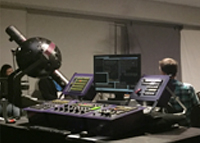 A new planetarium “ORPHEUS” was developed and introduced at the Pleiades National Planetarium Conference held at St. Louis, MO, USA. The ORPHEUS is for small and midium-sized dome (8m – 16m) and the world’s first planetarium equipped with all the 88 constellations and some other stunning features. The most unique feature is to turn stars on or off according to their brightness. Stars dimmer than magnitude 3.5 can be switched in groups of ½ magnitude each.
A new planetarium “ORPHEUS” was developed and introduced at the Pleiades National Planetarium Conference held at St. Louis, MO, USA. The ORPHEUS is for small and midium-sized dome (8m – 16m) and the world’s first planetarium equipped with all the 88 constellations and some other stunning features. The most unique feature is to turn stars on or off according to their brightness. Stars dimmer than magnitude 3.5 can be switched in groups of ½ magnitude each. |
|
2018
|
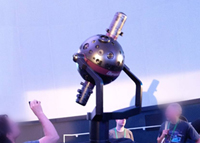 The ORPHEUS was presented at the International Planetarium Society conference in Toulouse, France. The installation of the demo projector in the Cité de l’espace 15-meter dome was the European premiere for the ORPHEUS.
The ORPHEUS was presented at the International Planetarium Society conference in Toulouse, France. The installation of the demo projector in the Cité de l’espace 15-meter dome was the European premiere for the ORPHEUS. |
|
2019
|
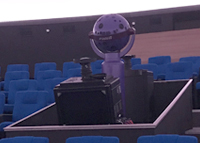 The PANDIA II HYBRID was installed at the planetarium (planet house) located within the Metropolitan Municipality Nihat Zeybekci Congress and Culture Center in Denizli, Turkey. The planetarium system consists of the PANDIAII opto-mechanical projector and RSA Cosmos SkyExplorer 4 digital software with fulldome video system.
The PANDIA II HYBRID was installed at the planetarium (planet house) located within the Metropolitan Municipality Nihat Zeybekci Congress and Culture Center in Denizli, Turkey. The planetarium system consists of the PANDIAII opto-mechanical projector and RSA Cosmos SkyExplorer 4 digital software with fulldome video system. |
|
2020
|
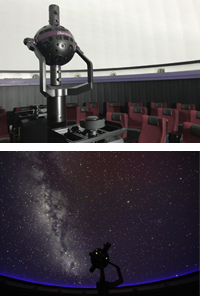 The ORPHEUS HYBRID was installed at the Byeolmaro Observatory located in Yeongwol-gun, Gangwon-do, Republic of Korea. The planetarium system consists of the ORPHEUS opto-mechanical projector and the VIRTUARIUM X digital software with fulldome video system.
The ORPHEUS HYBRID was installed at the Byeolmaro Observatory located in Yeongwol-gun, Gangwon-do, Republic of Korea. The planetarium system consists of the ORPHEUS opto-mechanical projector and the VIRTUARIUM X digital software with fulldome video system. |
|
2021
|
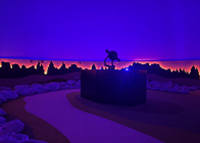 「ORPHEUS HYBRID」delivered to the Shanghai Astronomical Observatory (Shanghai, China), the world’s largest astronomical facility.
「ORPHEUS HYBRID」delivered to the Shanghai Astronomical Observatory (Shanghai, China), the world’s largest astronomical facility. |
|
2022
|
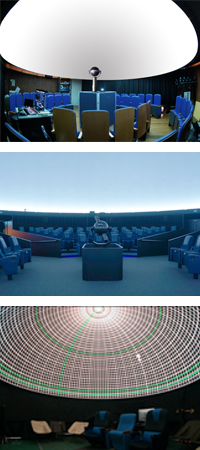 The new small-sized optical projector ”Atherios” that can be used in small domes has been released.The first Aetherios projector was delivered to the Mogami Large Area, Educational Research Center (Shinjo City, Yamagata, Japan).
The first “ORPHEUS HYBRID” in Europe was delivered to the LWL Museum of Natural History with Planetarium (Münster, Germany).
GOTO LED dome system has been developed.
The new small-sized optical projector ”Atherios” that can be used in small domes has been released.The first Aetherios projector was delivered to the Mogami Large Area, Educational Research Center (Shinjo City, Yamagata, Japan).
The first “ORPHEUS HYBRID” in Europe was delivered to the LWL Museum of Natural History with Planetarium (Münster, Germany).
GOTO LED dome system has been developed. |
|
2023
|
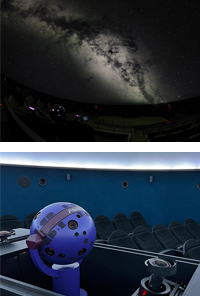 The star plate that reproduces the Milky Way with over 1 billion faint stars newly developed. A hybrid planetarium incorporating this star plate in “Chiron III” was delivered to “Dream 21” Higashiosaka City Children’s Culture and Sports Center (Osaka, Japan).
“PANDIAII HYBRID” was delivered to Luanda Science Center as the first planetarium in Angola.
The star plate that reproduces the Milky Way with over 1 billion faint stars newly developed. A hybrid planetarium incorporating this star plate in “Chiron III” was delivered to “Dream 21” Higashiosaka City Children’s Culture and Sports Center (Osaka, Japan).
“PANDIAII HYBRID” was delivered to Luanda Science Center as the first planetarium in Angola. |
 Seizo Goto established GOTO OPTICAL MFG. Co. as a private company in his house in Sangenjaya, Setagaya-ku, Tokyo. GOTO started manufacturing a single lens refractor telescope with effective aperture of 25mm and focal length of 80mm. Due to its unprecedented low price, orders from amateur astronomers rushed in.
Seizo Goto established GOTO OPTICAL MFG. Co. as a private company in his house in Sangenjaya, Setagaya-ku, Tokyo. GOTO started manufacturing a single lens refractor telescope with effective aperture of 25mm and focal length of 80mm. Due to its unprecedented low price, orders from amateur astronomers rushed in.  GOTO succeeded in photographing a total solar eclipse and the sun’s flash spectrum in Okoppe, Hokkaido, Japan with the cooperation of the Asahi Shimbun newspaper and was awarded a prize by the Ministry of Education and the Society of Astronomy in Japan. A movie of the eclipse, named “BLACK SUN” was produced.
GOTO succeeded in photographing a total solar eclipse and the sun’s flash spectrum in Okoppe, Hokkaido, Japan with the cooperation of the Asahi Shimbun newspaper and was awarded a prize by the Ministry of Education and the Society of Astronomy in Japan. A movie of the eclipse, named “BLACK SUN” was produced.  Astrorama (consisting of 5 projectors for 70mm 5 perf. film), the world’s first pano-hemispheric motion picture system, was delivered to the Midori Pavilion of EXPO’70. It was recognized as a pioneering facility exhibiting dome motion pictures for expos. After that, GOTO produced films with its own equipment and participated and planned projects for films at domestic and overseas events.
Astrorama (consisting of 5 projectors for 70mm 5 perf. film), the world’s first pano-hemispheric motion picture system, was delivered to the Midori Pavilion of EXPO’70. It was recognized as a pioneering facility exhibiting dome motion pictures for expos. After that, GOTO produced films with its own equipment and participated and planned projects for films at domestic and overseas events.  Ryuichiro Goto, grandson of founder Seizo Goto, was appointed President of GOTO.
Ryuichiro Goto, grandson of founder Seizo Goto, was appointed President of GOTO.  The new Fuchu factory (current building) was completed. GSS, the world’s first “space planetarium” allowing views of the solar system from other planets was developed. The first unit was delivered to the Yokohama Science Center, where a tilted space theater was born.
The new Fuchu factory (current building) was completed. GSS, the world’s first “space planetarium” allowing views of the solar system from other planets was developed. The first unit was delivered to the Yokohama Science Center, where a tilted space theater was born.  The GSSII for 18-23m domes, the next generation of GOTO Space System planetariums, was announced along with ASTROVISION 70, a pano-hemispheric motion picture. Both technologies supported a great variety of presentations in planetarium domes. GOTO won the bid for the first GSSII and Astrovision 70 system to the overseas market.
The GSSII for 18-23m domes, the next generation of GOTO Space System planetariums, was announced along with ASTROVISION 70, a pano-hemispheric motion picture. Both technologies supported a great variety of presentations in planetarium domes. GOTO won the bid for the first GSSII and Astrovision 70 system to the overseas market.  GSS-HELIOS, the world’s first ball-shaped planetarium with 4-axis control space simulation was completed. This design then became the mainstream design in large planetariums.
GSS-HELIOS, the world’s first ball-shaped planetarium with 4-axis control space simulation was completed. This design then became the mainstream design in large planetariums.  GSS-HELIOS was delivered to the Ehime Prefectural Science Museum (30m diameter dome). It made the Guinness Book of World Records for its world’s largest size.
The contract for the first tilted installation of the Model GSS-HELIOS/ASTROVISION 70 was agreed and it was delivered with an original show next year.
GSS-HELIOS was delivered to the Ehime Prefectural Science Museum (30m diameter dome). It made the Guinness Book of World Records for its world’s largest size.
The contract for the first tilted installation of the Model GSS-HELIOS/ASTROVISION 70 was agreed and it was delivered with an original show next year.  Virtuarium, the world’s first full-color, full-dome, three-dimensional computer graphic dome projection system rendered in real time was developed. It was announced to the world at the International Planetarium Society conference, which was held at Osaka, and shown to a post-conference group in Fuchu.
Virtuarium, the world’s first full-color, full-dome, three-dimensional computer graphic dome projection system rendered in real time was developed. It was announced to the world at the International Planetarium Society conference, which was held at Osaka, and shown to a post-conference group in Fuchu.  The ultra-high-intensity space planetarium, SUPER-HELIOS was announced.
The ultra-high-intensity space planetarium, SUPER-HELIOS was announced.  GSS-CHRONOS was developed following extensive user input. It was introduced at the International Planetarium Society’s 2002 conference and gained a strong reputation for incorporating a wide range of helpful opinions from teachers and schools, including digitally controlled planet mechanisms for the first time in medium and small-sized domes. It has since been delivered to many educational facilities in the USA and Japan.
GSS-CHRONOS was developed following extensive user input. It was introduced at the International Planetarium Society’s 2002 conference and gained a strong reputation for incorporating a wide range of helpful opinions from teachers and schools, including digitally controlled planet mechanisms for the first time in medium and small-sized domes. It has since been delivered to many educational facilities in the USA and Japan.  Nobutaka Goto, great-grandson of founder Seizo Goto, was appointed president of GOTO.
Virtuarium II, a second-generation fulldome digital projection system was announced. NEX, portable star ball projection system with which children can easily enjoy stars was released along with Hoshi-Tamago (Star Egg), a special inflatable dome for NEX.
The model GSS-URANUS and ASTROVISION 70LL system was delivered to the Egyptian Military Academy, making it the first ball-shaped planetarium in Egypt.
GOTO delivered a Model GS in the G series to ”El Pequeno Sula, Museo para la Infacia” of the City Hall of San Pedoro Sula, the Republic of Honduras under a Cultural Grant Aid of the Japanese Government. It was the first planetarium theater in Honduras.
Nobutaka Goto, great-grandson of founder Seizo Goto, was appointed president of GOTO.
Virtuarium II, a second-generation fulldome digital projection system was announced. NEX, portable star ball projection system with which children can easily enjoy stars was released along with Hoshi-Tamago (Star Egg), a special inflatable dome for NEX.
The model GSS-URANUS and ASTROVISION 70LL system was delivered to the Egyptian Military Academy, making it the first ball-shaped planetarium in Egypt.
GOTO delivered a Model GS in the G series to ”El Pequeno Sula, Museo para la Infacia” of the City Hall of San Pedoro Sula, the Republic of Honduras under a Cultural Grant Aid of the Japanese Government. It was the first planetarium theater in Honduras.
 The world’s first HYBRID planetarium, synchronizing a GOTO SUPER URANUS opto-mechanical planetarium and a fulldome digital projection system was delivered to the Morioka Children’s Museum of Science in northern Japan.
The world’s first HYBRID planetarium, synchronizing a GOTO SUPER URANUS opto-mechanical planetarium and a fulldome digital projection system was delivered to the Morioka Children’s Museum of Science in northern Japan.  For the 2005 World Exposition, Aichi, Japan, GOTO delivered 4 unique projection systems. The world’s first 360 degree, spherical projection system was installed at the Japanese Government Pavilion and 3 other projection systems were installed at the Global Village, Mitsubishi Future Pavilion and Ireland Pavilion.
GOTO built friendly relations with the American Museum of Natural History in New York City after cooperation for production of “Cosmic Collisions” and cooperated in the production of “Journey to the Stars” (2008) and “Dark Universe” (2013).
For the 2005 World Exposition, Aichi, Japan, GOTO delivered 4 unique projection systems. The world’s first 360 degree, spherical projection system was installed at the Japanese Government Pavilion and 3 other projection systems were installed at the Global Village, Mitsubishi Future Pavilion and Ireland Pavilion.
GOTO built friendly relations with the American Museum of Natural History in New York City after cooperation for production of “Cosmic Collisions” and cooperated in the production of “Journey to the Stars” (2008) and “Dark Universe” (2013).
 The highly publicized total sphere projection system at the Aichi Expo was transferred to the National Science Museum in Ueno, Tokyo.
The highly publicized total sphere projection system at the Aichi Expo was transferred to the National Science Museum in Ueno, Tokyo.  GOTO installed the state of art, HYBRID planetarium, “CHIRON HYBRID” into the Sudekum Planetarium, Adventure Science Center, Nashville, USA and in large planetarium theaters in JAPAN.
GOTO joined the four-dimensional digital universe project (4D2U) in Japan’s National Observatory and developed a 3D image show for this data visualization theater.
GOTO installed the state of art, HYBRID planetarium, “CHIRON HYBRID” into the Sudekum Planetarium, Adventure Science Center, Nashville, USA and in large planetarium theaters in JAPAN.
GOTO joined the four-dimensional digital universe project (4D2U) in Japan’s National Observatory and developed a 3D image show for this data visualization theater.
 The new Sendai Astronomical Observatory opened. GOTO operates and manages the observatory on behalf of the Sendai Astronomy Service Corporation.
GOTO installed the full dome image system VIRTARIUM II into the National Science Museum, Korea and increased popularity of the planetarium.
The new Sendai Astronomical Observatory opened. GOTO operates and manages the observatory on behalf of the Sendai Astronomy Service Corporation.
GOTO installed the full dome image system VIRTARIUM II into the National Science Museum, Korea and increased popularity of the planetarium.
 SUPER-HELIOS HYBRID was delivered to China Science & Technology Museum, China and CHIRON HYBRID was delivered to Planetarium (Nay Pyi Taw) Myanmar.
A planetarium system installed by other maker was updated WITH HYBRID technology by GOTO and installed “VIRTUARIUM II”.
It became possible to integrally control other maker’s optical planetarium with our full dome digital projection system. The HYBRID SYSTEM facilities are increasing at home and overseas.
SUPER-HELIOS HYBRID was delivered to China Science & Technology Museum, China and CHIRON HYBRID was delivered to Planetarium (Nay Pyi Taw) Myanmar.
A planetarium system installed by other maker was updated WITH HYBRID technology by GOTO and installed “VIRTUARIUM II”.
It became possible to integrally control other maker’s optical planetarium with our full dome digital projection system. The HYBRID SYSTEM facilities are increasing at home and overseas.
 The super luminosity, LED-equipped CHRONOS II and PANDIA were released. The first CHRONOS II was delivered to Shinagawa City Gotanda Culture Center and the first PANDIA was installed at the renovated international terminal of Tokyo (Haneda) International Airport.
The super luminosity, LED-equipped CHRONOS II and PANDIA were released. The first CHRONOS II was delivered to Shinagawa City Gotanda Culture Center and the first PANDIA was installed at the renovated international terminal of Tokyo (Haneda) International Airport.  An LED-equipped CHIRON was introduced as CHIRON II and installed in Tama Rokuto Science Center in 2012. This has been recognized as the “Most advanced planetarium” in the world.
GOTO installed a “CHRONOS II HYBRID” into the Raumflugplanetarium Juri Gararin in Cottbus, Germany, the country where the planetarium was born. It expanded the sales to Europe.
The first full dome digital show program “A PLANET FOR GOLDILOCKS” intended for overseas distribution was announced at the IPS conference held at Baton Rouge, USA. This show won the Best Audio Track award at the IMILOA FULLDOME FILM FESTIVAL, Hawaii, USA.
An LED-equipped CHIRON was introduced as CHIRON II and installed in Tama Rokuto Science Center in 2012. This has been recognized as the “Most advanced planetarium” in the world.
GOTO installed a “CHRONOS II HYBRID” into the Raumflugplanetarium Juri Gararin in Cottbus, Germany, the country where the planetarium was born. It expanded the sales to Europe.
The first full dome digital show program “A PLANET FOR GOLDILOCKS” intended for overseas distribution was announced at the IPS conference held at Baton Rouge, USA. This show won the Best Audio Track award at the IMILOA FULLDOME FILM FESTIVAL, Hawaii, USA.  GOTO developed “CHIRON III” which has all stars showing their intrinsic color temperature.
The first PANDIA HYBRID to overseas market was installed into HwaCheon ChouKyongChol Observatory, Korea and secondly into the Planetarium Ostrava, Czech Republic.
GOTO developed “CHIRON III” which has all stars showing their intrinsic color temperature.
The first PANDIA HYBRID to overseas market was installed into HwaCheon ChouKyongChol Observatory, Korea and secondly into the Planetarium Ostrava, Czech Republic.
 Based on the GOTO Model CHIRON III, a special “CHIRON 4○1” was created and installed at Yokkaichi Municipal Museum, Japan. The successor to PANDIA, the Model PANDIA II was developed with digital shutters built into the starball, allowing use in tilted domes. (Note: PANDIA projectors are named PANDORA in Japan)
Based on the GOTO Model CHIRON III, a special “CHIRON 4○1” was created and installed at Yokkaichi Municipal Museum, Japan. The successor to PANDIA, the Model PANDIA II was developed with digital shutters built into the starball, allowing use in tilted domes. (Note: PANDIA projectors are named PANDORA in Japan)  2016 marked a unique, third installation of a GOTO projector in a single American planetarium. The College of San Mateo (California) completed its upgrade from a CHRONOS HYBRID with 2K fulldome video to a new CHRONOS II HYBRID with 4K fulldome video in January. This upgrade followed an earlier replacement of their original CHRONOS projector after it was destroyed in flooding. GOTO INC is very proud to receive such customer loyalty and confirmation of the HYBRID concept by our users.
For the first time in 14 years, GOTO INC made an international premiere of one of its opto-mechanical projectors at the International Planetarium Society’s 2016 conference in Warsaw, Poland. A 16m air dome was temporary home to a CHIRON III HYBRID installation in cooperation with RSA Cosmos. Hundreds of planetarians from around the world marveled at the HYBRID’s precision of synchronization, ease of manual control, and of course the beautiful CHIRON III sky.
GOTO INC delivered Japan’s first real 8K fulldome projection system to Fukui City Museum of Astronomy “SEIREN PLANET” and delivered GOTO CHIRON III HYBRID system to Sapporo Science center.
2016 marked a unique, third installation of a GOTO projector in a single American planetarium. The College of San Mateo (California) completed its upgrade from a CHRONOS HYBRID with 2K fulldome video to a new CHRONOS II HYBRID with 4K fulldome video in January. This upgrade followed an earlier replacement of their original CHRONOS projector after it was destroyed in flooding. GOTO INC is very proud to receive such customer loyalty and confirmation of the HYBRID concept by our users.
For the first time in 14 years, GOTO INC made an international premiere of one of its opto-mechanical projectors at the International Planetarium Society’s 2016 conference in Warsaw, Poland. A 16m air dome was temporary home to a CHIRON III HYBRID installation in cooperation with RSA Cosmos. Hundreds of planetarians from around the world marveled at the HYBRID’s precision of synchronization, ease of manual control, and of course the beautiful CHIRON III sky.
GOTO INC delivered Japan’s first real 8K fulldome projection system to Fukui City Museum of Astronomy “SEIREN PLANET” and delivered GOTO CHIRON III HYBRID system to Sapporo Science center.  A new planetarium “ORPHEUS” was developed and introduced at the Pleiades National Planetarium Conference held at St. Louis, MO, USA. The ORPHEUS is for small and midium-sized dome (8m – 16m) and the world’s first planetarium equipped with all the 88 constellations and some other stunning features. The most unique feature is to turn stars on or off according to their brightness. Stars dimmer than magnitude 3.5 can be switched in groups of ½ magnitude each.
A new planetarium “ORPHEUS” was developed and introduced at the Pleiades National Planetarium Conference held at St. Louis, MO, USA. The ORPHEUS is for small and midium-sized dome (8m – 16m) and the world’s first planetarium equipped with all the 88 constellations and some other stunning features. The most unique feature is to turn stars on or off according to their brightness. Stars dimmer than magnitude 3.5 can be switched in groups of ½ magnitude each.  The ORPHEUS was presented at the International Planetarium Society conference in Toulouse, France. The installation of the demo projector in the Cité de l’espace 15-meter dome was the European premiere for the ORPHEUS.
The ORPHEUS was presented at the International Planetarium Society conference in Toulouse, France. The installation of the demo projector in the Cité de l’espace 15-meter dome was the European premiere for the ORPHEUS.  The PANDIA II HYBRID was installed at the planetarium (planet house) located within the Metropolitan Municipality Nihat Zeybekci Congress and Culture Center in Denizli, Turkey. The planetarium system consists of the PANDIAII opto-mechanical projector and RSA Cosmos SkyExplorer 4 digital software with fulldome video system.
The PANDIA II HYBRID was installed at the planetarium (planet house) located within the Metropolitan Municipality Nihat Zeybekci Congress and Culture Center in Denizli, Turkey. The planetarium system consists of the PANDIAII opto-mechanical projector and RSA Cosmos SkyExplorer 4 digital software with fulldome video system.  The ORPHEUS HYBRID was installed at the Byeolmaro Observatory located in Yeongwol-gun, Gangwon-do, Republic of Korea. The planetarium system consists of the ORPHEUS opto-mechanical projector and the VIRTUARIUM X digital software with fulldome video system.
The ORPHEUS HYBRID was installed at the Byeolmaro Observatory located in Yeongwol-gun, Gangwon-do, Republic of Korea. The planetarium system consists of the ORPHEUS opto-mechanical projector and the VIRTUARIUM X digital software with fulldome video system.  「ORPHEUS HYBRID」delivered to the Shanghai Astronomical Observatory (Shanghai, China), the world’s largest astronomical facility.
「ORPHEUS HYBRID」delivered to the Shanghai Astronomical Observatory (Shanghai, China), the world’s largest astronomical facility.  The new small-sized optical projector ”Atherios” that can be used in small domes has been released.The first Aetherios projector was delivered to the Mogami Large Area, Educational Research Center (Shinjo City, Yamagata, Japan).
The first “ORPHEUS HYBRID” in Europe was delivered to the LWL Museum of Natural History with Planetarium (Münster, Germany).
GOTO LED dome system has been developed.
The new small-sized optical projector ”Atherios” that can be used in small domes has been released.The first Aetherios projector was delivered to the Mogami Large Area, Educational Research Center (Shinjo City, Yamagata, Japan).
The first “ORPHEUS HYBRID” in Europe was delivered to the LWL Museum of Natural History with Planetarium (Münster, Germany).
GOTO LED dome system has been developed.  The star plate that reproduces the Milky Way with over 1 billion faint stars newly developed. A hybrid planetarium incorporating this star plate in “Chiron III” was delivered to “Dream 21” Higashiosaka City Children’s Culture and Sports Center (Osaka, Japan).
“PANDIAII HYBRID” was delivered to Luanda Science Center as the first planetarium in Angola.
The star plate that reproduces the Milky Way with over 1 billion faint stars newly developed. A hybrid planetarium incorporating this star plate in “Chiron III” was delivered to “Dream 21” Higashiosaka City Children’s Culture and Sports Center (Osaka, Japan).
“PANDIAII HYBRID” was delivered to Luanda Science Center as the first planetarium in Angola. 